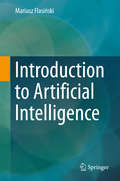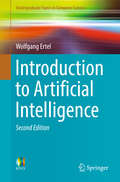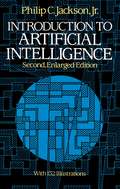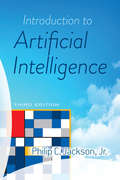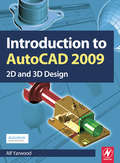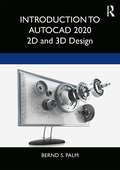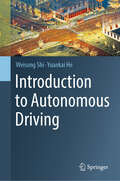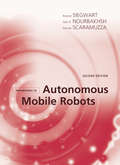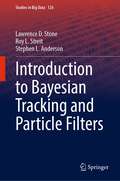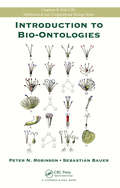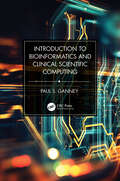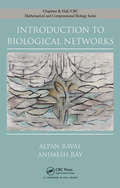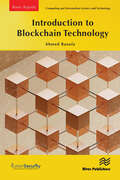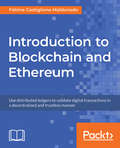- Table View
- List View
Introduction to Artificial Intelligence
by Mariusz FlasińskiIn the chapters in Part I of this textbook the author introduces the fundamental ideas of artificial intelligence and computational intelligence. In Part II he explains key AI methods such as search, evolutionary computing, logic-based reasoning, knowledge representation, rule-based systems, pattern recognition, neural networks, and cognitive architectures. Finally, in Part III, he expands the context to discuss theories of intelligence in philosophy and psychology, key applications of AI systems, and the likely future of artificial intelligence. A key feature of the author's approach is historical and biographical footnotes, stressing the multidisciplinary character of the field and its pioneers. The book is appropriate for advanced undergraduate and graduate courses in computer science, engineering, and other applied sciences, and the appendices offer short formal, mathematical models and notes to support the reader.
Introduction to Artificial Intelligence
by Wolfgang Ertel Nathanael T. BlackThis concise and accessible textbook supports a foundation or module course on A.I., covering a broad selection of the subdisciplines within this field. The book presents concrete algorithms and applications in the areas of agents, logic, search, reasoning under uncertainty, machine learning, neural networks and reinforcement learning. Topics and features: presents an application-focused and hands-on approach to learning the subject; provides study exercises of varying degrees of difficulty at the end of each chapter, with solutions given at the end of the book; supports the text with highlighted examples, definitions, and theorems; includes chapters on predicate logic, PROLOG, heuristic search, probabilistic reasoning, machine learning and data mining, neural networks and reinforcement learning; contains an extensive bibliography for deeper reading on further topics; supplies additional teaching resources, including lecture slides and training data for learning algorithms, at an associated website.
Introduction to Artificial Intelligence
by Wolfgang ErtelThis accessible and engaging textbook presents a concise introduction to the exciting field of artificial intelligence (AI). The broad-ranging discussion covers the key subdisciplines within the field, describing practical algorithms and concrete applications in the areas of agents, logic, search, reasoning under uncertainty, machine learning, neural networks, and reinforcement learning. Fully revised and updated, this much-anticipated second edition also includes new material on deep learning. Topics and features: presents an application-focused and hands-on approach to learning, with supplementary teaching resources provided at an associated website; contains numerous study exercises and solutions, highlighted examples, definitions, theorems, and illustrative cartoons; includes chapters on predicate logic, PROLOG, heuristic search, probabilistic reasoning, machine learning and data mining, neural networks and reinforcement learning; reports on developments in deep learning, including applications of neural networks to generate creative content such as text, music and art (NEW); examines performance evaluation of clustering algorithms, and presents two practical examples explaining Bayes' theorem and its relevance in everyday life (NEW); discusses search algorithms, analyzing the cycle check, explaining route planning for car navigation systems, and introducing Monte Carlo Tree Search (NEW); includes a section in the introduction on AI and society, discussing the implications of AI on topics such as employment and transportation (NEW). Ideal for foundation courses or modules on AI, this easy-to-read textbook offers an excellent overview of the field for students of computer science and other technical disciplines, requiring no more than a high-school level of knowledge of mathematics to understand the material.
Introduction to Artificial Intelligence (AI)
by Ahmed BanafaIntroduction to Artificial Intelligence (AI) provides a comprehensive overview of the latest trends in artificial intelligence. The book covers the state of the art in AI research, including machine learning, natural language processing, computer vision, and robotics.The book offers a forward-looking perspective on the future of AI, exploring the emerging trends and applications that are likely to shape the next decade of AI innovation. It also provides practical guidance for businesses and individuals on how to leverage the power of AI to create new products, services, and opportunities.Overall, the book is an essential read for anyone who wants to stay ahead of the curve in the rapidly evolving field of AI and understand the impact that this transformative technology will have on our lives in the coming years.
Introduction to Artificial Intelligence (Dover Books on Mathematics)
by Philip C. Jackson Jr.Can computers think? Can they use reason to develop their own concepts, solve complex problems, play games, understand our languages? This comprehensive survey of artificial intelligence ― the study of how computers can be made to act intelligently ― explores these and other fascinating questions. Introduction to Artificial Intelligence presents an introduction to the science of reasoning processes in computers, and the research approaches and results of the past two decades. You'll find lucid, easy-to-read coverage of problem-solving methods, representation and models, game playing, automated understanding of natural languages, heuristic search theory, robot systems, heuristic scene analysis and specific artificial-intelligence accomplishments. Related subjects are also included: predicate-calculus theorem proving, machine architecture, psychological simulation, automatic programming, novel software techniques, industrial automation and much more.A supplementary section updates the original book with major research from the decade 1974-1984. Abundant illustrations, diagrams and photographs enhance the text, and challenging practice exercises at the end of each chapter test the student's grasp of each subject.The combination of introductory and advanced material makes Introduction to Artificial Intelligence ideal for both the layman and the student of mathematics and computer science. For anyone interested in the nature of thought, it will inspire visions of what computer technology might produce tomorrow.
Introduction to Artificial Intelligence (Undergraduate Topics in Computer Science)
by Wolfgang ErtelThis accessible and engaging textbook presents a concise introduction to the exciting field of artificial intelligence (AI). The broad-ranging discussion covers the key subdisciplines within the field, describing practical algorithms and concrete applications in the areas of agents, logic, search, reasoning under uncertainty, machine learning, neural networks, and reinforcement learning. Fully revised and updated, this much-anticipated third edition also includes new material on deep learning.Topics and features:· Presents an application-focused and hands-on approach to learning, with supplementary teaching resources provided at an associated website · Introduces convolutional neural networks as the currently most important type of deep learning networks with applications to image classification (NEW) · Contains numerous study exercises and solutions, highlighted examples, definitions, theorems, and illustrative cartoons · Reports on developments in deep learning, including applications of neural networks to large language models as used in state-of-the-art chatbots as well as to the generation of music and art (NEW) · Includes chapters on predicate logic, PROLOG, heuristic search, probabilistic reasoning, machine learning and data mining, neural networks, and reinforcement learning · Covers various classical machine learning algorithms and introduces important general concepts such as cross validation, data normalization, performance metrics and data augmentation (NEW)· Includes a section on AI and society, discussing the implications of AI on topics such as employment and transportation Ideal for foundation courses or modules on AI, this easy-to-read textbook offers an excellent overview of the field for students of computer science and other technical disciplines, requiring no more than a high-school level of knowledge of mathematics to understand the material.Dr. Wolfgang Ertel is a professor at the Institute for Artificial Intelligence at the Ravensburg-Weingarten University of Applied Sciences, Germany.
Introduction to Artificial Intelligence: Third Edition (Dover Books On Mathematics Ser.)
by Philip C. JacksonCan computers think? Can they use reason to develop their own concepts, solve complex problems, understand our languages? This updated edition of a comprehensive survey includes extensive new text on "Artificial Intelligence in the 21st Century," introducing deep neural networks, conceptual graphs, languages of thought, mental models, metacognition, economic prospects, and research toward human-level AI.Ideal for both lay readers and students of computer science, the original text features abundant illustrations, diagrams, and photographs as well as challenging exercises. Lucid, easy-to-read discussions examine problem-solving methods and representations, game playing, automated understanding of natural languages, heuristic search theory, robot systems, heuristic scene analysis, predicate-calculus theorem proving, automatic programming, and many other topics.
Introduction to Audio Processing
by Mads G. ChristensenThis textbook presents an introduction to signal processing for audio applications. The author’s approach posits that math is at the heart of audio processing and that it should not be simplified. He thus retains math as the core of signal processing and includes concepts of difference equations, convolution, and the Fourier Transform. Each of these is presented in a context where they make sense to the student and can readily be applied to build artifacts. Each chapter in the book builds on the previous ones, building a linear, coherent story. The book starts with a definition of sound and goes on to discuss digital audio signals, filters, The Fourier Transform, audio effects, spatial effects, audio equalizers, dynamic range control, and pitch estimation. The exercises in each chapter cover the application of the concepts to audio signals. The exercises are made specifically for Pure Data (Pd) although traditional software, such as MATLAB, can be used. The book is intended for students in media technology bachelor programs. The book is based on material the author developed teaching on the topic over a number of years.
Introduction to AutoCAD 2009
by Alf YarwoodAlf Yarwood provides a practical, structured course of work matched to the latest release of AutoCAD. After introducing first principles and the creation of 2D technical drawings, he goes on to demonstrate the construction of 3D solid and surface model drawings and rendering. All the new features of the 2009 software release are taken into account and the increasing emphasis on 3D solid modelling in the software is reflected in the book. The 2D chapters are also suitable for those learning how to use AutoCAD LT 2009.Suitable for all new users of AutoCAD, this book is particularly applicable to vocational and introductory level undergraduate courses in engineering and construction. It is an ideal textbook for the City & Guilds Computer Aided Design and Engineering qualifications (4353 and 2303)and the relevant CAD units of BTEC National and BTEC Higher National Engineering and Construction schemes from Edexcel.A free companion website is available at http://books.elsevier.com/companions/9780750689830 and features: Worked solutions and AutoCAD drawing files of stages and results for the exercises in the bookFurther exercises and multiple-choice questions with answers.
Introduction to AutoCAD 2010
by Alf YarwoodAlf Yarwood provides a practical, structured course of work matched to the latest release of AutoCAD. After introducing first principles and the creation of 2D technical drawings, he goes on to demonstrate the construction of 3D solid drawings, surface model drawings and rendering. All the new features of the 2010 software release are taken into account and the increasing emphasis on 3D solid modelling in the software is reflected in the book. The 2D chapters are also suitable for those learning how to use AutoCAD LT 2010.Suitable for all new users of AutoCAD, this book is particularly applicable to vocational and introductory level undergraduate courses in engineering and construction. Further Education students in the UK will find this an ideal textbook to cater for the City & Guilds 4353 and 2303 qualifications and the relevant CAD units of BTEC National and BTEC Higher National Engineering and Construction schemes from Edexcel. Many Foundation Degrees also contain CAD modules for which this book can be of use.Readers will also be able to visit a free companion website at http://books.elsevier.com/companions/9781856178686, where they will find worked solutions and AutoCAD drawing files of stages and results for the exercises in the book, as well as further exercises and multiple-choice questions with answers.
Introduction to AutoCAD 2012
by Alf YarwoodMaster the complexities of the world’s bestselling 2D and 3D software with Alf Yarwood’s new Introduction to AutoCAD 2012. Ideally suited to new users of AutoCAD, this book will be a useful resource for drawing modules in both vocational and introductory undergraduate courses in engineering and construction.Alf Yarwood has once again produced a comprehensive, step-by-step introduction to the latest release of AutoCAD. Covering all the basic principles and acting as an introduction to 2D drawing, it also contains extensive coverage of all 3D topics, including 3D solid modelling and rendering.A fold-out list of frequently used keyboard shortcuts will help you perform actions quickly while working through the book, and an appendix of ribbon references clearly describes all the software tools that are used throughout the book.Further education students in the UK will find this an invaluable textbook for City and Guilds AutoCAD qualifications as well as the relevant Computer Aided Drawing units of BTEC National Engineering, Higher National Engineering and Construction courses from Edexcel. Students enrolled in Foundation Degree courses containing CAD modules will also find this a very useful reference and learning aid.Readers will also be able to visit a free companion website at:www.introtoautocad2012.com where they will find worked solutions and AutoCAD drawing files of stages, and results for the exercises in this book, as well as further exercises and multiple-choice questions with answers.
Introduction to AutoCAD 2017: 2D and 3D Design
by Alf Yarwood Bernd S. PalmMaster the complexities of the world's bestselling 2D and 3D software with Introduction to AutoCAD 2017. Ideally suited to new users of AutoCAD, this book will be a useful resource for drawing modules in both vocational and introductory undergraduate courses in engineering and construction. A comprehensive, step-by-step introduction to the latest release of AutoCAD. Covering all the basic principles and acting as an introduction to 2D drawing, it also contains extensive coverage of all 3D topics, including 3D solid modelling and rendering. Written by a member of the Autodesk Developer Network. Hundreds of colour pictures, screenshots and diagrams illustrate every stage of the design process. Worked examples and exercises provide plenty of practice material to build proficiency with the software. Further education students will find this an invaluable textbook for City & Guilds AutoCAD qualifications as well as the relevant Computer Aided Drawing units of BTEC National Engineering, Higher National Engineering and Construction courses from Edexcel. Students enrolled in Foundation Degree courses containing CAD modules will also find this a very useful reference and learning aid.
Introduction to AutoCAD 2020: 2D and 3D Design
by Bernd S. PalmMaster the complexities of the world's bestselling 2D and 3D software with Introduction to AutoCAD 2020. Ideally suited to new users, and relevant for both AutoCAD 2020 and AutoCAD 2021, this book will be a useful resource for drawing modules in both vocational and introductory undergraduate courses in engineering and construction. Experienced users will also find the updated images, commands and software information to be essential reading in order to adapt to the latest AutoCAD interface. A comprehensive, step-by-step introduction to the latest release of AutoCAD. Covering all the basic principles and acting as an introduction to 2D drawing, it also contains extensive coverage of all 3D topics, including 3D solid modelling and rendering. Written by a member of the Autodesk Developer Network. Hundreds of colour pictures, screenshots and diagrams illustrate every stage of the design process. Worked examples and exercises provide plenty of practice material to build proficiency with the software. Further education students will find this an invaluable textbook for City & Guilds AutoCAD qualifications as well as the relevant Computer Aided Drawing units of BTEC National Engineering, Higher National Engineering and Construction courses from Edexcel. Students enrolled in Foundation Degree courses containing CAD modules will also find this a very useful reference and learning aid.
Introduction to Autonomous Driving
by Weisong Shi Yuankai HeThis book offers an accessible introduction to the fast-moving world of autonomous driving. Aimed at students, researchers, and professionals, it provides both a comprehensive overview and a hands-on guide to the core concepts and practical tools used to build self-driving cars. Autonomous driving stands at the intersection of artificial intelligence, robotics, embedded systems, and transportation engineering. Over the past two decades, the field has advanced from speculative prototypes to road-tested systems with significant industrial and societal impact. This textbook reflects that evolution, offering readers a structured yet flexible entry point into the autonomous vehicle (AV) ecosystem. Key topics include how autonomous vehicles perceive their surroundings, determine their location, plan routes, and make driving decisions. Each chapter bridges foundational concepts with real-world applications using open-source platforms such as ROS2, CARLA, BlueICE, and Autoware.Universe. Readers will gain hands-on experience through simulation environments, real-world datasets, and modular development tools. A unique emphasis on experiential learning encourages active engagement with the complexities of AV development. From simulating sensor fusion to implementing planning strategies and security protocols, learners interact directly with the technical and design challenges inherent in the field. Reflection exercises throughout the book emphasize ethical considerations and the societal implications of AV technology—underscoring the importance of responsible innovation alongside technical fluency. While some background in programming and mathematics is helpful, the content is designed to be approachable and engaging for a broad audience interested in the future of mobility. The organization of the text—from foundational chapters on perception and localization to advanced discussions of full-stack systems and industry trends—mirrors the layered architecture of an actual autonomous vehicle. Introduction to Autonomous Driving equips readers not only with the skills needed to contribute to AV projects today, but also with the conceptual clarity and critical perspective required for leadership in this transformative domain.
Introduction to Autonomous Manipulation
by Giacomo Marani Junku Yuh"Autonomous manipulation" is a challenge in robotic technologies. It refers to the capability of a mobile robot system with one or more manipulators that performs intervention tasks requiring physical contacts in unstructured environments and without continuous human supervision. Achieving autonomous manipulation capability is a quantum leap in robotic technologies as it is currently beyond the state of the art in robotics. This book addresses issues with the complexity of the problems encountered in autonomous manipulation including representation and modeling of robotic structures, kinematic and dynamic robotic control, kinematic and algorithmic singularity avoidance, dynamic task priority, workspace optimization and environment perception. Further development in autonomous manipulation should be able to provide robust improvements of the solutions for all of the above issues. The book provides an extensive tract on sensory-based autonomous manipulation for intervention tasks in unstructured environments. After presenting the theoretical foundations for kinematic and dynamic modelling as well as task-priority based kinematic control of multi-body systems, the work is focused on one of the most advanced underwater vehicle-manipulator system, SAUVIM (Semi-Autonomous Underwater Vehicle for Intervention Missions). Solutions to the problem of target identification and localization are proposed, a number of significant case studies are discussed and practical examples an d experimental/simulation results are presented. The book may inspire the robot research community to further investigate critical issues in autonomous manipulation and to develop robot systems that can profoundly impact our society for the better.
Introduction to Autonomous Mobile Robots, second edition (Intelligent Robotics and Autonomous Agents series)
by Roland Siegwart Illah Reza Nourbakhsh Davide ScaramuzzaThe second edition of a comprehensive introduction to all aspects of mobile robotics, from algorithms to mechanisms.Mobile robots range from the Mars Pathfinder mission's teleoperated Sojourner to the cleaning robots in the Paris Metro. This text offers students and other interested readers an introduction to the fundamentals of mobile robotics, spanning the mechanical, motor, sensory, perceptual, and cognitive layers the field comprises. The text focuses on mobility itself, offering an overview of the mechanisms that allow a mobile robot to move through a real world environment to perform its tasks, including locomotion, sensing, localization, and motion planning. It synthesizes material from such fields as kinematics, control theory, signal analysis, computer vision, information theory, artificial intelligence, and probability theory. The book presents the techniques and technology that enable mobility in a series of interacting modules. Each chapter treats a different aspect of mobility, as the book moves from low-level to high-level details. It covers all aspects of mobile robotics, including software and hardware design considerations, related technologies, and algorithmic techniques.This second edition has been revised and updated throughout, with 130 pages of new material on such topics as locomotion, perception, localization, and planning and navigation. Problem sets have been added at the end of each chapter. Bringing together all aspects of mobile robotics into one volume, Introduction to Autonomous Mobile Robots can serve as a textbook or a working tool for beginning practitioners.Curriculum developed by Dr. Robert King, Colorado School of Mines, and Dr. James Conrad, University of North Carolina-Charlotte, to accompany the National Instruments LabVIEW Robotics Starter Kit, are available. Included are 13 (6 by Dr. King and 7 by Dr. Conrad) laboratory exercises for using the LabVIEW Robotics Starter Kit to teach mobile robotics concepts.
Introduction to Autonomous Robots: Mechanisms, Sensors, Actuators, and Algorithms
by Nikolaus Correll Bradley Hayes Christoffer Heckman Alessandro RonconeA comprehensive introduction to the field of autonomous robotics aimed at upper-level undergraduates and offering additional online resources.Textbooks that provide a broad algorithmic perspective on the mechanics and dynamics of robots almost unfailingly serve students at the graduate level. Introduction to Autonomous Robots offers a much-needed resource for teaching third- and fourth-year undergraduates the computational fundamentals behind the design and control of autonomous robots. The authors use a class-tested and accessible approach to present progressive, step-by-step development concepts, alongside a wide range of real-world examples and fundamental concepts in mechanisms, sensing and actuation, computation, and uncertainty. Throughout, the authors balance the impact of hardware (mechanism, sensor, actuator) and software (algorithms) in teaching robot autonomy. Features:Rigorous and tested in the classroomWritten for engineering and computer science undergraduates with a sophomore-level understanding of linear algebra, probability theory, trigonometry, and statisticsQR codes in the text guide readers to online lecture videos and animationsTopics include: basic concepts in robotic mechanisms like locomotion and grasping, plus the resulting forces; operation principles of sensors and actuators; basic algorithms for vision and feature detection; an introduction to artificial neural networks, including convolutional and recurrent variantsExtensive appendices focus on project-based curricula, pertinent areas of mathematics, backpropagation, writing a research paper, and other topicsA growing library of exercises in an open-source, platform-independent simulation (Webots)
Introduction to Bayesian Tracking and Particle Filters (Studies in Big Data #126)
by Roy L. Streit Lawrence D. Stone Stephen L. AndersonThis book provides a quick but insightful introduction to Bayesian tracking and particle filtering for a person who has some background in probability and statistics and wishes to learn the basics of single-target tracking. It also introduces the reader to multiple target tracking by presenting useful approximate methods that are easy to implement compared to full-blown multiple target trackers.The book presents the basic concepts of Bayesian inference and demonstrates the power of the Bayesian method through numerous applications of particle filters to tracking and smoothing problems. It emphasizes target motion models that incorporate knowledge about the target’s behavior in a natural fashion rather than assumptions made for mathematical convenience.The background provided by this book allows a person to quickly become a productive member of a project team using Bayesian filtering and to develop new methods and techniques for problems the team may face.
Introduction to Bio-Ontologies (Chapman & Hall/CRC Computational Biology Series)
by Peter N. Robinson Sebastian BauerIntroduction to Bio-Ontologies explores the computational background of ontologies. Emphasizing computational and algorithmic issues surrounding bio-ontologies, this self-contained text helps readers understand ontological algorithms and their applications.The first part of the book defines ontology and bio-ontologies. It also explains the importan
Introduction to Bioinformatics and Clinical Scientific Computing
by Paul S. GanneyThis textbook provides an introduction to computer science theory, informatics best practice, and the standards and legislation that apply to computing in a healthcare environment. It delivers an accessible discussion of databases (construction, interrogation and maintenance); networking (design and low-level application); programming (best practice rather than the specifics of any one language – design, maintenance, safety). It can be used to accompany the NHS Modernising Scientific Careers syllabus. It is also targeted towards those creating software rather than those using it, particularly computer scientists working in healthcare, specifically those in or close to the Physical Sciences, including radiotherapy, nuclear medicine, and equipment management and those working with genomics and health informatics.
Introduction to Biological Networks
by Alpan Raval Animesh RayThe new research area of genomics-inspired network biology lacks an introductory book that enables both physical/computational scientists and biologists to obtain a general yet sufficiently rigorous perspective of current thinking. Filling this gap, Introduction to Biological Networks provides a thorough introduction to genomics-inspired network bi
Introduction to Biometrics (Texts in Computer Science)
by Anil K. Jain Arun A. Ross Karthik Nandakumar Thomas SwearingenThis textbook introduces the fundamental concepts and techniques used in biometric recognition to students, practitioners, and non-experts in the field. Specifically, the book describes key methodologies used for sensing, feature extraction, and matching of commonly used biometric modalities such as fingerprint, face, iris, and voice. In addition, it presents techniques for fusion of biometric information to meet stringent accuracy requirements, also discussing various security issues and associated remedies involved in the deployment of biometric systems. Furthermore, this second edition captures the progress made in the field of biometric recognition, with highlights including: Lucid explanation of core biometric concepts (e.g., individuality and persistence), which builds a strong foundation for more in-depth study and research on biometrics A new chapter on deep neural networks that provides a primer to recent advancements in machine learning and computer vision Illustrative examples of how deep neural network models have contributed to the rapid evolution of biometrics in areas such as robust feature representation and synthetic biometric data generation A new chapter on speaker recognition, which introduces the readers to person recognition based on the human voice characteristics Presentation of emerging security threats such as deepfakes and adversarial attacks and sophisticated countermeasures such as presentation attack detection and template security While this textbook has been designed for senior undergraduate students and first-year graduate students studying a course on biometrics, it is also a useful reference guide for biometric system designers, developers, and integrators.
Introduction to Blender 3.0: Learn Organic and Architectural Modeling, Lighting, Materials, Painting, Rendering, and Compositing with Blender
by Gianpiero MoioliMaster the basics of 3D modeling for art, architecture, and design by exploring Blender 3.0. This book explains modeling, materials, lighting, painting, and more with Blender and other external tools.You will configure a 3D architectural environment and set up the workflow of an art and design project within Blender. You will use Blender's main tools—mesh modeling and sculpting—to create virtual objects and environments. And, you will explore building materials and light scenes, followed by drawing and virtual painting. Chapters cover rendering scenes and transforming them into 2D images or videos. You will learn to use Blender 3.0 for video editing as a compositor and video sequence editor (VSE or sequencer) with a wide range of effects available through the nodal system.On completing this book, you will have the knowledge to create art, design, and architecture with this 3D modeler.What You Will LearnCreate objects and architectural buildings with different techniques of 3D modelingMaster creating an environment for your objects and how to light themDetermine how to create node materials and assign them to your Blender objectsPick up UV unwrapping and texture paintingGet closer to painting and drawing in BlenderRender your scenes and create stunning videosWho This Book Is ForArtists, designers, architects, and animation artists who want to learn Blender by tackling the challenges of building high-end computer graphics, art, design, and architecture. Ideal for readers with little-to-no experience with Blender as it starts with the basics and covers techniques to produce objects, materials, environments.
Introduction to Blockchain Technology (River Publishers Series in Rapids in Computing and Information Science and Technology)
by Ahmed BanafaThis book explores the fundamentals and applications of Blockchain technology. Readers will learn about the decentralized peer-to-peer network, distributed ledger, and the trust model that defines Blockchain technology. They will also be introduced to the basic components of Blockchain (transaction, block, block header, and the chain), its operations (hashing, verification, validation, and consensus model), underlying algorithms, and essentials of trust (hard fork and soft fork). Private and public Blockchain networks similar to Bitcoin and Ethereum will be introduced, as will concepts of Smart Contracts, Proof of Work and Proof of Stack. Blockchain is an emerging technology that can radically improve transaction security at banking, supply chain, and other transaction networks. It’s estimated that Blockchain will generate $3.1 trillion in new business value by 2030. Essentially, it provides the basis for a dynamic distributed ledger that can be applied to save time when recording transactions between parties, remove costs associated with intermediaries, and reduce risks of fraud and tampering.
Introduction to Blockchain and Ethereum: Use distributed ledgers to validate digital transactions in a decentralized and trustless manner
by Fatima Castiglione MaldonadoBuild distributed applications that resolve data ownership issues when working with transactions between multiple partiesKey FeaturesExplore a perfect balance between theories and hands-on activitiesDiscover popular Blockchain use cases such as BitcoinCreate your first smart contract in Solidity for EthereumBook DescriptionBlockchain applications provide a single-shared ledger to eliminate trust issues involving multiple stakeholders. With the help of Introduction to Blockchain and Ethereum, you'll learn how to create distributed Blockchain applications which do not depend on a central server or datacenter. The course begins by explaining Bitcoin, Altcoins, and Ethereum, followed by taking you through distributed programming using the Solidity language on the Ethereum Blockchain. By the end of this course, you'll be able to write, compile, and deploy your own smart contracts to the Ethereum Blockchain.What you will learnGrasp Blockchain concepts such as private and public keys, addresses, wallets, and hashesSend and analyze transactions in the Ethereum Rinkeby test networkCompile and deploy your own ERC20-compliant smart contracts and tokensTest your smart contracts using MyEtherWalletCreate a distributed web interface for your contractCombine Solidity and JavaScript to create your very own decentralized applicationWho this book is forIntroduction to Blockchain and Ethereum is ideal for you if you want to get to grips with Blockchain technology and develop your own distributed applications with smart contracts written in Solidity. Prior exposure to an object-oriented programming language such as JavaScript is needed, as you'll cover the basics before getting straight to work.
